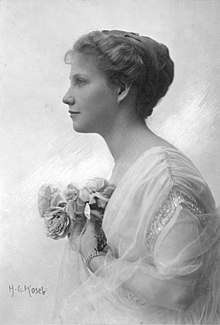Margaretha of Austria-Tuscany
Margaretha of Austria-Tuscany , full name Margaretha Rainiera Maria Antonia Blanka Leopoldina Beatrix Anna Josephina Raphaela Michaela Stanislawa Ignatia Alice Cäcilia (* May 8, 1894 in Lemberg ; † January 21, 1986 in Rome ) came from the Tuscan branch of the House of Habsburg . She was by birth Archduchess of Austria and Princess of Tuscany . After the end of the monarchy, she lived in Spain from 1919, then mostly in Italy from 1936.
Life
Childhood and youth
Archduchess Margaretha, born in 1894 in Lemberg (now Lviv in western Ukraine), which was then part of the Austro-Hungarian monarchy , was the third daughter of Archduke Leopold Salvator (1863–1931) from the House of Habsburg-Lothringen (Habsburg-Lothringen-Tuscany line) and his family Wife Blanka of Bourbon-Castile (1868–1949). She was named after her maternal grandmother Margarita von Bourbon-Parma (1847-1893); in the family circle she was called Meg . In the final phase of the Habsburg monarchy, she grew up with her siblings on various estates of their parents. When the family was in Vienna , they lived mainly in the Tuscany Palace and Wilhelminenberg Palace . In addition, she was vacationing in Italy on an estate owned by Margaretha's mother near Viareggio .
Archduchess Margaretha received her education together with her two slightly older sisters Maria de los Dolores (1891–1974) and Maria Immaculata (1892–1971). Like them, Margaretha had an artistic disposition and, in addition to her mother tongue German, learned French, Spanish, Hungarian and Italian as foreign languages. During the First World War , she worked in the nursing sector and, like her sister Maria Immaculata, worked for the Austrian Red Cross .
Life in exile
After the end of World War I and the fall of the Habsburg monarchy, Margaretha and most of her family, whose assets were confiscated, moved to Spain in early 1919. They lived modestly in Barcelona , but Margaretha, her mother and unmarried siblings had to leave Spain when the Spanish Civil War broke out in 1936. The following year, on November 27, 1937, Margaretha, who was 43 years old, married the six years older Italian diplomat Francesco Maria Taliani, Marchese de Marchio (1887–1968) at Sonnberg Castle in Lower Austria , which belonged to her brother Archduke Anton .
In 1938 Taliani was appointed the Italian ambassador to China and moved to Nanjing with his wife Margaretha . At that time Japan was occupying parts of China including Nanjing, and when Italy gave up its previous role as an ally of Germany and Japan during the Second World War in September 1943 and surrendered to the Allies, Margaretha and her husband became one by order of the Japanese until the summer of 1945 Concentration camp interned in China. At the beginning of 1946 the diplomatic couple returned to Italy and bought a house in Venice . In February 1951, the couple moved to Spain, where Taliani served as Italian ambassador to the Franco government . In 1952 he was retired and settled in Rome with his wife. In March 1968 Margaretha became a widow and now lived alternately in Rome and on the La Tenuata reale estate near Viareggio, which she shared with her sisters Maria de los Dolores and Maria Immaculata. The Archduchess, who had also worked as a painter, died in 1986, childless and very old, at the age of 91 and bequeathed her estate to the municipality of Viareggio, which was to serve it as a public cultural center. The deceased was buried in Ascoli Piceno. Her nephew Dominik (* 1937) inherited her fortune.
literature
- Margareta , in: Brigitte Hamann (Ed.): Die Habsburger , 1988, p. 282.
Remarks
- ↑ So Darryl Lundy: Margaretha Archduchess of Austria , on The Peerage.com; at Brigitte Hamann ( The Habsburgs , 1988, p 282) is 21 June 1986 as the date of death given Margaretha.
| personal data | |
|---|---|
| SURNAME | Margaretha of Austria-Tuscany |
| BRIEF DESCRIPTION | Habsburg Archduchess |
| DATE OF BIRTH | May 8, 1894 |
| PLACE OF BIRTH | Lviv , Austria-Hungary |
| DATE OF DEATH | January 21, 1986 |
| Place of death | Rome , Italy |


